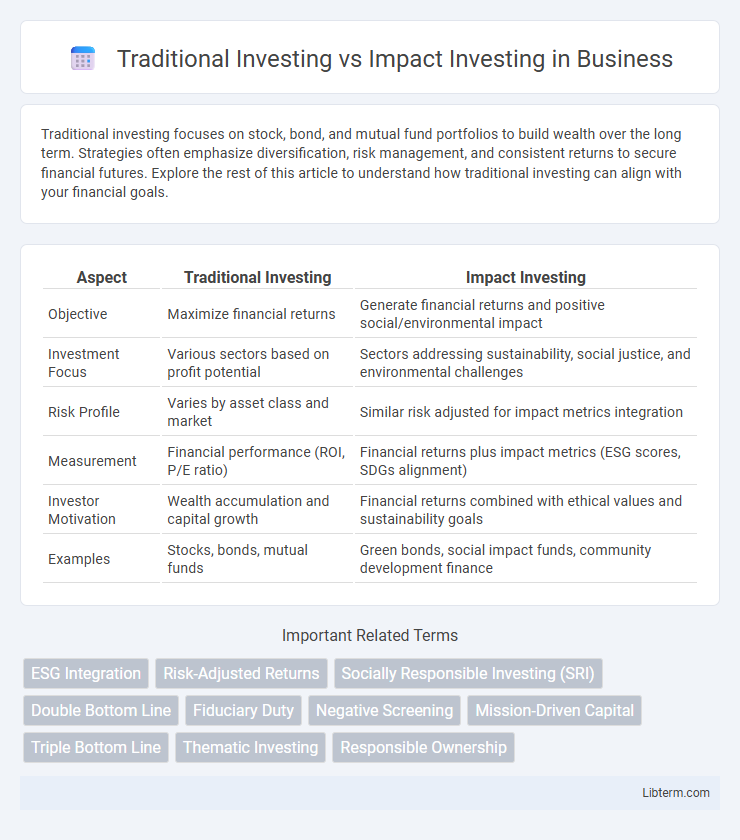Traditional investing focuses on stock, bond, and mutual fund portfolios to build wealth over the long term. Strategies often emphasize diversification, risk management, and consistent returns to secure financial futures. Explore the rest of this article to understand how traditional investing can align with your financial goals.
Table of Comparison
| Aspect | Traditional Investing | Impact Investing |
|---|---|---|
| Objective | Maximize financial returns | Generate financial returns and positive social/environmental impact |
| Investment Focus | Various sectors based on profit potential | Sectors addressing sustainability, social justice, and environmental challenges |
| Risk Profile | Varies by asset class and market | Similar risk adjusted for impact metrics integration |
| Measurement | Financial performance (ROI, P/E ratio) | Financial returns plus impact metrics (ESG scores, SDGs alignment) |
| Investor Motivation | Wealth accumulation and capital growth | Financial returns combined with ethical values and sustainability goals |
| Examples | Stocks, bonds, mutual funds | Green bonds, social impact funds, community development finance |
Understanding Traditional Investing
Traditional investing prioritizes financial returns by allocating capital primarily into stocks, bonds, and real estate based on risk tolerance and expected profitability. Investors analyze historical market data, company earnings, and economic indicators to optimize portfolio performance. This approach often emphasizes short-term gains and shareholder value without explicitly considering environmental or social outcomes.
What is Impact Investing?
Impact investing directs capital to companies, organizations, and funds with the intention of generating measurable social and environmental benefits alongside financial returns. Unlike traditional investing, which primarily focuses on maximizing financial gain, impact investing prioritizes positive outcomes in areas such as renewable energy, sustainable agriculture, and affordable healthcare. This approach appeals to investors seeking to align their portfolios with values related to social responsibility and long-term global sustainability.
Key Differences Between Traditional and Impact Investing
Traditional investing primarily aims for financial returns by allocating capital to stocks, bonds, and other assets based on risk and profitability metrics. Impact investing integrates social and environmental goals with financial performance, targeting measurable positive outcomes alongside competitive returns. The key differences lie in investment objectives, with traditional investing focused on maximizing shareholder value, whereas impact investing balances financial gains with purposeful, mission-driven impact.
Financial Returns: Myths and Realities
Traditional investing prioritizes maximizing financial returns by focusing on market-driven metrics, while impact investing aims to generate measurable social and environmental benefits alongside competitive financial performance. Studies reveal that impact investments can match or exceed traditional investment returns, debunking the myth that socially responsible strategies compromise profitability. Data from Morgan Stanley and Global Impact Investing Network indicate that impact portfolios often deliver risk-adjusted returns comparable to conventional funds, challenging assumptions about trade-offs between purpose and profit.
Measuring Social and Environmental Impact
Traditional investing primarily emphasizes financial returns and market performance metrics, often overlooking social and environmental outcomes. Impact investing integrates rigorous measurement frameworks like ESG scores, IRIS+, and the Global Impact Investing Network (GIIN) standards to quantify social and environmental impact alongside financial gains. This dual-focus approach enables investors to assess the tangible benefits of their investments on communities and ecosystems while maintaining portfolio profitability.
Risk Analysis in Both Investment Approaches
Traditional investing primarily evaluates risk based on financial metrics such as market volatility, credit risk, and liquidity, aiming to maximize returns within acceptable risk levels. Impact investing incorporates these financial risks but adds layers of environmental, social, and governance (ESG) risk analysis, considering long-term sustainability and ethical impacts on communities and ecosystems. While traditional investing risks often center on short-term market fluctuations, impact investing evaluates both financial performance and non-financial outcomes, potentially leading to diversified risk profiles and resilience against social and environmental disruptions.
Investor Motivations and Objectives
Traditional investing primarily focuses on maximizing financial returns and portfolio growth, driven by objectives such as capital appreciation, income generation, and risk management. Impact investing seeks to generate measurable social or environmental benefits alongside competitive financial returns, appealing to investors motivated by values and a desire for positive change. Investor motivations in impact investing emphasize alignment with personal ethics and long-term sustainability, differentiating it from the profit-centric goals of traditional investing.
Popular Examples and Case Studies
Traditional investing typically centers on financial returns through assets like stocks, bonds, and real estate, with popular examples including Warren Buffett's Berkshire Hathaway and index funds like the S&P 500. Impact investing prioritizes measurable social and environmental benefits alongside profits, exemplified by funds such as the Calvert Impact Capital and case studies like the renewable energy projects funded by the Global Impact Investing Network (GIIN). Both strategies offer valuable insights into balancing financial goals with long-term societal impact.
Challenges and Limitations
Traditional investing faces challenges such as prioritizing short-term financial returns, which may overlook social and environmental impacts, potentially leading to unsustainable business practices. Impact investing encounters limitations including difficulty in measuring non-financial outcomes, lack of standardized metrics, and the risk of "impact washing" where investments claim social benefits without substantial evidence. Both approaches require balancing financial performance with responsibility, often constrained by market volatility and regulatory uncertainties.
The Future of Investing: Trends and Predictions
Traditional investing, centered on financial returns, faces a shift as impact investing gains momentum by prioritizing environmental, social, and governance (ESG) criteria alongside profit. Emerging trends indicate a rise in ESG-centric portfolios, with asset managers incorporating climate risk assessments and social impact metrics to meet growing investor demand. Predictive models suggest that by 2030, impact investing could represent a significant portion of global assets under management, driven by regulatory changes and heightened awareness of sustainable development goals (SDGs).
Traditional Investing Infographic

 libterm.com
libterm.com